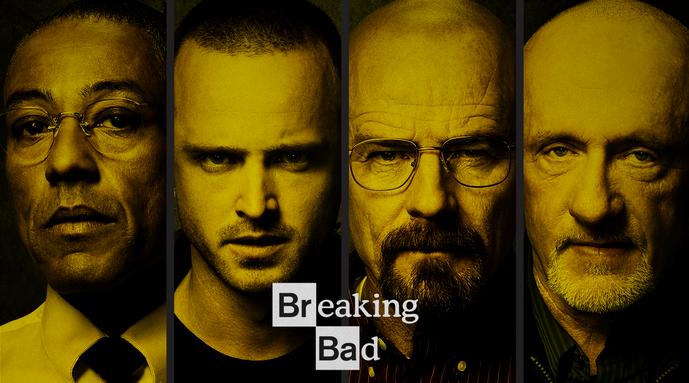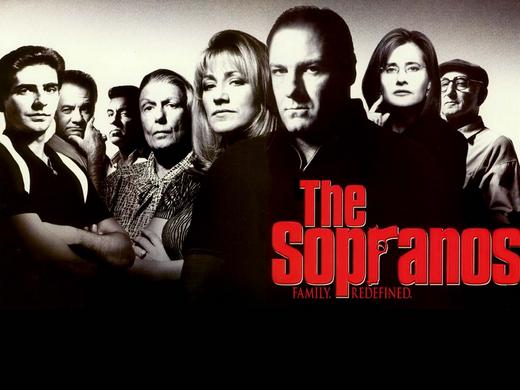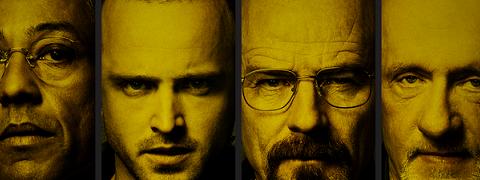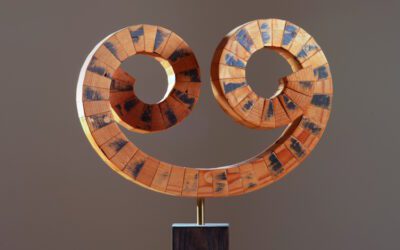[dropcap style=”font-size:100px; color:#992211;”]B[/dropcap]reaking Bad (currently in its final season) is hip, darkly humorous, and utterly captivating.
Its critical acclaim is unanimous and for good reason: it is filled with fantastically crafted characters; the development of the plot has been veritably Shakespearian; its set pieces thrill and entertain in equal measure. All of this has already been written to death. You can’t flick through a magazine without finding one of countless rhapsodic reports on the show. So as the series comes to its dramatic close, perhaps it’s time to add something new to the discussion.
[THIS ARTICLE CONTAINS SPOILERS FOR THE TELEVISION PROGRAMMES BREAKING BAD, THE SOPRANOS, AND LOST.]
A big part of why the show is so compelling is its structure, both seasonal and episodic. With regards the latter, something that seems to be a staple for Breaking Bad is a masterful building of tension leading to… a cut-to-black.
The snowballing momentum of these final episodes seems to hinge on this technique.
This reflects not only upon the direction the show has taken in terms of tone, but also something wider: the recent appropriation of a cinematic aesthetic by television.
What does a cut-to-black achieve?
The technique has been used often in cinema, and to varying effects. In terms of horror, look to Frederick Wiseman’s 1968 documentary High School, a disturbing investigation into the appalling conduct of teachers at a Philadelphian High School.
In the final scene the Principal reads a letter from a recent graduate of the film (who’s now serving in Vietnam). In this letter he refers to himself as “only a body doing a job” and thanks the school for the lessons he learned there. The Principal is content at this, seeing the letter only as confirmation of how successful the school is.
Following this moment, the cut-to-black leaves the viewer breathless with dread.
For a comedic effect, Jim Jarmusch’s 1984 dead-pan comedy Stranger Than Paradise makes use of the technique throughout. Indeed, film comedy has always depended on the establishment of a rhythm and, in the case of Jarmusch, he holds the shot for slightly longer than he should before punctuating the awkwardness with a cut to black. The film’s first act ends with Cousin Eva leaving for Cleveland and Willie and Eddie having a beer together in Willie’s apartment. Both men lean slightly forward in their chairs as if they are about to speak. But nothing happens. Cut to black.
Here, Jarmusch uses the cut as a punch-line to his deadpan anti-joke. It’s amazing how funny a black screen can be.
It seems that to achieve these effects, it comes down to the audience waiting for something which never comes, but is instead replaced by a black screen (in the case of horror, waiting for catharsis – in the case of comedy, waiting for a punch-line). Interestingly (and perhaps for similar reasons) it’s also a device that can be used politically. Kirk Boyle wrote an essay called ‘Children of Men and I Am Legend : the disaster-capitalism complex hits Hollywood’ in which he argued that the dual use of a cut to black and voiceover at the end of I Am Legend “can only be interpreted as an injunction addressed to the audience… we must “light up the darkness.” In other words, [the character] Anna commands us to convert non-believing ‘dark seekers’ to Christianity.”
This is a provocative action that is used in a similar way in documentaries. Here, Kirk is arguing that the cut-to-black (which replaces the action which never comes) actually becomes a command for the audience themselves to act.
The blurring of the line between cinema and television
There used to be a definite distinction between the two media, but we now live in an era where a (now former) filmmaker like Steven Soderbergh happily made his last ever movie with TV network HBO. Something has changed. As Steven Soderbergh announced at Cannes: “TV is really taking control of a conversation that used to be sort of the exclusive domain of movies.”
[quote]Where there was
something, there is now
nothing; a void. Whatever
the audience was about
to be granted is snatched
away[/quote]
In the past decade or so (and particularly on networks like HBO and AMC) there have been notable examples of television series that look and feel like cinema. Among the cinematic facets that television has appropriated comes, first and foremost, a higher budget. And this doesn’t just apply to production; viewers have more sophisticated viewing equipment at home – bigger screens with higher definition and surround sound systems.
In this HD-ready era in which technology has reached the point whereby everyone has a cinema in their front rooms, the grammar of television has progressed as well. Suddenly shows can afford to use multiple cameras and get out of the studio during the shoot. And that means that complex editing styles are possible. Visual effects (that actually look good) become a feasible option. In short, the pragmatic televisual grammar of old is no longer necessary.
The extent to which this is true became suddenly apparent for many in the industry when, in 2006 (while being interviewed for the French film magazine Positif) Alain Resnais praised the skilful mise-en-scene of Kim Manners, director of 52 episodes of The X-Files, adding that in a great deal of television he found “the cinematic syntax more rich and inventive than in the majority of cinema.”
The use of cut-to-black in television
It is interesting that the more cinematic television shows are where the cut-to-black technique begins to appear more frequently. The language of television is all family friendly editing and reassuring recurrence. There is no scope for black screens, for unexpected absence; there is no room for tense stillness, nor for silence. But the language of cinema is creeping onto the small screen. 
Damon Lindeloff and JJ Abrams’ Lost is a great example of a recent show wherein the use of film grammar defines one’s experience of watching it. Indeed, Lost‘s two-part pilot episode reportedly cost between $10 and $14 million, which was the most expensive in the network’s history (to put that in context, the average cost of an hour-long pilot in 2005 was $4 million). Up until that point a scene depicting a man running through a (real) jungle to a beach and finding the wreckage of a recently crashed Boeing 777 would have been confined to the realms of cinema.
And, of course, it’s a series that’s structured around the cut-to-black technique. Each episode inevitably ends with a lead-on to the next episode (a character announcing a course of action; an sequence of events put in motion; a narrative-changing reveal etc) followed by a sudden cut to a black screen emblazoned with the title in white lettering, with a doom-laden boom ringing out.
In a nutshell, this mostly concerns pacing. The structure becomes strictly rhythmic in order to achieve its effects, like music or poetry. Indeed, we have reached a point whereby the serialized television format has become a prosodic art-form comparable with poetry. It is an art of fissures and (as with sounds, lines, and stanzas in poetry) the viewing habits suddenly require a persistent process of breaking and reconnecting images, character relationships and plot points.
In looking at these episodes as a part of a whole season, it becomes apparent that each episode is broken by the repeated cut-to-black, which is a dramatic cadence of sorts. The booming black screen becomes a repeated motif, keeping the tempo in a similar way to the repeated lines in the pantoum or the rondeau in poetry.
When viewed in this way, the cut to white that punctuates the finale of the fifth series works as an anti-rhyme, pulling the viewer out of the expected and into what Abrams would refer to as a mystery box (for an explanation see his TEDx talk here). It’s the polar opposite of what viewers came to expect at the end of each episode of Lost, and as such the whiteness represents infinite interpretation and possibility.
This article wouldn’t be complete without mentioning the end of The Sopranos. The cut to black that shocked a nation, that shook it to its core and had it running to check that its television cable was still working. There have been a great many discussions on what that scene means, ranging from ‘the cut was the moment of Tony’s murder’ to ‘they’re all in purgatory’. What remains certain is that the most memorable and provocative moment from all six seasons was its final and abrupt cut.
In the September issue of Sight and Sound, Matt Zoller Seltz offered the most fascinating opinion on it yet. Arguing that David Chase had made us live with these violent men for eight years, that Chase had made us implicit in their crimes, almost condoning their actions by rooting for them (Seltz calls it an “attraction-repulsion” series that “made you care about characters you’d find terrifying or disgusting in life”).
When Chase walks his characters into that diner, he doesn’t want to appease the viewer’s guilt by whacking Tony – it is the viewer that gets whacked. Chase yanked that world away from us, a world of violence that we had revelled in, in order to “get us to admit who we really are and what we want from art.”
Breaking Bad
Within both cinema and television then, a cut to black can be used to induce horror, comedy, even political provocation. It is both a method for poetic structuring and bringing the viewer into the world of the show (as well as pulling them right out of it again). Breaking Bad, it could be argued has achieved all this and more throughout its five seasons. Indeed, the cut-to-black has never it been used as effectively, prolifically and poetically anywhere else.
Vince Gilligan has said in interviews that Breaking Bad started as an idea of creating show in which a sympathetic protagonist became a terrifying antagonist. Revisiting the show, this becomes clear. If we look all the way back to season 1 (which premiered in 2008) we find episodes ending in an entertaining, even light-hearted manner. The pilot episode for instance ends with Walt’s first taste of criminality resulting in renewed sexual vigour, the cut to black occurring at the precipice of coitus.
Likewise episode 6 “Crazy Handful of Nothin’” ends with Walt (having just had his first taste of power and violence) driving off in a family station wagon, whilst surrounded by gang members on Harleys. The cut-to-black pulls us from captivation into an awareness that these absurd images are actually pretty amusing.
In terms of poetics and pacing, Gilligan finds the perfect points to cut episodes off, leaving vast numbers of sprawling questions breaking over the viewer. Look at ending of episode 2 “The Cat’s in the Bag…” with the child finding one of Walt and Jesse’s incriminating gas masks, or the end of episode 5 “Grey Matter” ending with Walt and Jesse standing off and the simple line “Wanna cook?”
Images and moments like these linger long after the episodes have finished with the black screens acting as ellipses or question marks – punctuation that demands the viewer’s attention long after the episode has finished.
As the seasons continue, the drama of each episode mushrooms out. We got a taste of what would come to define Breaking Bad in episode 3: “And the Bag’s in the River.” which ended in the White’s bedroom with the line “Skyler, there’s something I have to tell you…” cut-to-black and silence. Again in season 2 with episode 2 ”Grilled” which ends with Hank shooting Tuco and then, looking up, hearing the dinging of Hector’s bell. As the screen cuts-to-black, the ringing continues.
Gilligan enjoys teasing the viewer with these truly Hitchcockian levels of suspense. How can you take another week of not knowing what the fuck happens after the screen turns black?
Season 3, episode 2: “Caballo Sin Nombre” is a classic example of the kind of dramatic irony and expert pacing that Gilligan can unleash upon his audience. Two assassins from the drug Cartel turn up at Walt’s house to kill him. They sit on his bed (one holding an axe) waiting for him to come out of the shower, but at the last moment receive a text calling them away. The cut that follows is not only a question-laden moment of absolute suspense, but the sudden black screen also serves as a visual manifestation of the fate Walt only just unwittingly dodged.
One of the most horrifying cut-to-blacks of the series comes at the end of Season 4’s finale: “Face off”. The camera zooms in on the Lily of the Valley potted plant, the song ends, and the screen is abruptly engulfed in darkness.
The awful realisation of what this means truly settles in as the viewer is gut-wrenchingly pulled out of the show again. Towards the end of that episode Gilligan has just about convinced us of Walt’s return to good nature, to the extent that the cut to black is equivocal to being slapped around the face with the facts. We’ve been rooting for a man who would willingly murder an innocent child.
With the final season, Gilligan has pulled out all the stops with one wholly compelling episode after another. Ep 9, “Blood Money” (the first of the final 8 episodes) ends with Hank’s inevitable confrontation of Walt, after finding out that he is the infamous ‘Heisenberg’ whom Hank has been hunting since season 1.
Following a physical and verbal brawl, Hank (looking a combination of deeply confused and utterly terrified) whispers “I don’t know who I’m talking to.” To which Walt replies “If that’s true, if you don’t know who I am… Then, maybe your best course… would be to tread lightly.” A slightly wider angle shows the two men standing completely still, inches apart from each other. And cut.
The moment is shattering: it is tense, emotional, thought-provoking, and ultimately awe-inspiring. Awe at the gall that Gilligan displays at leaving the viewer hanging at such a tense moment, with so many fears and questions, with so much at stake. Awe at the artistry of the performances that are cut away at the tip of such a climax. Awe at the darkness which we are now presented with.
Conclusion
And so Vince Gilligan (among others) recognised a certain quality in the simplicity of a cut-to-black. The question remains: why does the black screen have this effect? The answer remains abstract.
The world in which we were so immersed is suddenly no longer in existence. Where there was something, there is now nothing; a void. Whatever the audience was about to be granted is snatched away. And this is a shock to the system. There is now only darkness. A pure, simple absence. There is only mystery, a blank space that you can fill with your fears, hopes, desires.
The darkness is not only visual, but aural and deafening. The resonance of the last sounds we heard remain, ringing in our ears; the images imprinted in our minds. The mind races as the possibility of where the next episode could take us flows like a river bursting at its banks.
In essence, the show goes on. And on. And on.






















